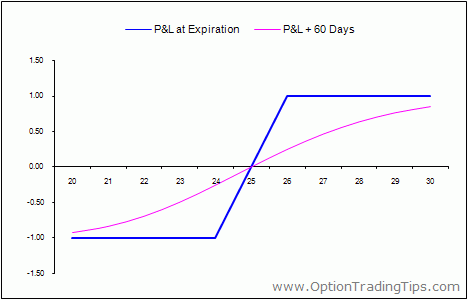Vertical option spread strategy bull put spread
Post on: 6 Июнь, 2015 No Comment

In this article, I will cover the bull put trade as part of my five-part series on vertical spreads. (If you missed my previous articles, start here .)
I have already covered two specific kinds of vertical call spreads, the bear call and the bull call. While both are built with calls, one strategy is bullish and one is bearish.
A bullish or bearish vertical position can be built with either calls or puts (but remember, vertical spreads are constructed with the same class option, i.e. either both calls or both puts).
The fine difference that I use in my option trading to determine whether to use calls or puts, is determined by implied volatility (IV) .
Choosing the Right Vertical Spread Strategy
If I have a bullish outlook on a certain underlying, then I can go with either a bull put (vertical put sell, or credit put spread) or a bull call (vertical call buy, or debit call spread).
One of the easiest ways to choose between the two vertical option strategies is to simply check the pricing of the premium. Many traders spend multiple hours in the selection of a perfect entry point, yet, at the end, they overpay their fill due to premium overpricing.
The main reason why the premium would be overvalued is the IV.
As I pointed out in my Verticals and Volatility article, I solve the selection of the vertical strategy dilemma by simply having the IV determine the strategy.
If the IV is low or in its lower range, then I go with a vertical debit spread (bullish or bearish, depending on my outlook); either a bull call or a bear put. If, however, the IV is high or in its higher range, then I certainly should not be a buyer of options, so I would do a vertical credit spread; either a bear call or a bull put, again depending on my current forecast for the underlying.
Now that we have that straightened out, I want to go into more depth on the bull put.
The Bull Put Spread
A bull put, just as any other vertical spread. involves buying one option first and then simultaneously selling another one for the same expiration month but at a different strike price and on the same underlying, of course.
A bull put is a credit spread. for the price paid for the long put option is less than the premium received for the short put producing a net credit. The maximum value of the spread at expiration is equal to the difference between the strike prices.
Due to the fact that IV is currently sitting at its lower range, I will not provide any current, real-life examples of it, but a theoretical one.
Bull Put Example
To construct a bull put you need to buy one put and then sell another put with a higher strike price. The lower-strike put always costs less than the higher-strike put.
If the underlying is at $39 and the trader has a neutral-to-bullish outlook, then the trader could select the following strike prices: Buy the 35 put and sell the higher strike price or 40 put.
The figure above assigns prices of premium to the two strike prices in order to point out that the maximum profit on this vertical credit put spread is $150 minus commissions.
The goal of a bull put is to keep as much of that net credit of $150 as possible. I want to emphasize the words, as much as possible. Yet, what also needs to be kept in mind is how much is at risk in this hypothetical trade.
I have mentioned above that the maximum value of a spread at the expiration is equal to the difference between the strike prices.
The statement means the difference between the 40 put and the 35 put is 5 points, which in our case translates to $500, for the basic assumption is that we are dealing with a single option contract.
If our max profit is $150, then our max loss is the difference between the strike prices and the credit we have taken in: $500 $150 = $350.

There are three possible outcomes to this trade, which are visually displayed below.
The bad scenario would mean that the underlying dropped below the lower (bought) strike price, bestowing upon the trader the maximum loss. Hopefully, the trader should be monitoring his or her bull put position actively and see that the price is dropping. At that point, he or she should close the spread to recover whatever value is left in the spread.
At no point should vertical spreads be placed and forgotten about.
The good outcome is when the price of the underlying goes above the sold put. The goal of a bull put is to keep as much of the net credit as possible.
The in-between outcome means that the underlying closes in between the two strike prices; in such a situation, the question becomes how near the underlying is to the bought put.
The break-even point (BEP) is the difference between the higher put strike price and the credit received: 40 put minus the credit of $1.50 equals $38.50.
Hence, in our example, the underlying could even go against us a bit (in the amount of the credit received) before we actually start losing money.
In conclusion, the goal of this article was to explain the vertical credit put and emphasize the point that the selling of it should be done when the IV of the underlying is at its 52-week high, or at least in the higher range.
Go on to the last installment of this series, which covers bear put spreads .
3 Secrets to Quicker, Bigger Global Profits
Learn how to target the next winning global stocks in three easy steps without the risk. Plus, the best red-hot China stock to buy now. Download your FREE investing guide here.














